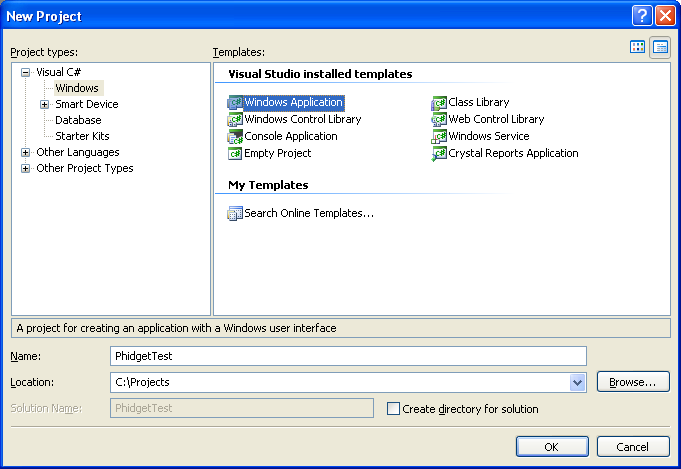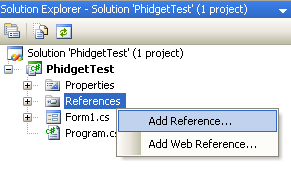Language - Max/MSP: Difference between revisions
| Line 56: | Line 56: | ||
To run the examples, you first download them [[#Quick Downloads|from above]] and unpack them into a folder. | To run the examples, you first download them [[#Quick Downloads|from above]] and unpack them into a folder. Here, you will find example programs, in {{code | help}} format for all the devices. If you aren't sure what the software example for your device is called, check the software object listed in the [[Device List | Getting Started guide for your device]]. | ||
The only thing left to do is to run the examples! Open the {{code| .help}} file in the Max environment. | |||
[[File:CSharp VS2005 Run.PNG ]] | |||
Once you have the Max/MSP examples running, we have a [[#Follow The Examples|teaching section]] below to help you follow them. | |||
=====Write Your Own Code===== | =====Write Your Own Code===== | ||
| Line 98: | Line 92: | ||
The same [[#Follow The Examples|teaching section]] which describes the examples also has further resources for programming your Phidget. | The same [[#Follow The Examples|teaching section]] which describes the examples also has further resources for programming your Phidget. | ||
==Mac OS X== | ==Mac OS X== | ||
Revision as of 22:19, 24 January 2012
![]() Max/MSP, developed by Cycling74 is a visual programming language for creating music and media applications.
Max/MSP, developed by Cycling74 is a visual programming language for creating music and media applications.
Introduction
Only Max/MSP 4.5 or higher is supported.
Quick Downloads
Just need the Max/MSP drivers, libraries, and examples? Here they are:
API Documentation: Should we include the next 2 links?
- General API (more help on functions common to all Phidgets)
- Device Specific APIs (more help on functions specific to your Phidget)
Max/MSP Library and Example Code:
Libraries and Drivers:
- 32 bit Windows (drivers, with libraries)
- 64 bit Windows (drivers, with libraries)
- General Linux Libraries ( Linux Library Setup Instructions)
- General Mac OSX Libraries ( Mac OS X Library Setup Instructions)
Getting started with Max/MSP
If you are new to writing code for Phidgets, we recommend starting by running, then modifying existing examples. This will allow you to:
- Make sure your libraries are properly linked
- Go from source code to a test application as quickly as possible
- Ensure your Phidget is hooked up properly
Instructions are divided up by operating system. Choose:
Windows(2000/XP/Vista/7)
Libraries
Description
Max/MSP programs on Windows depend on the following files, which the installers above put onto your system:
phidget21.dllcontains the actual Phidgets library, which is used at run-time. If you used our installer, it's already correctly placed inC:\Windows\System32. It can be manually installed - check our Manual Installation instructions.
You will also need one of the following two files, depending on the .NET framework version you are targeting:
Phidget<Device Name>.mxeis the Phidgets library for your specific device. Please make sure the.mxefile corresponds with the device you are using. For example, if you are using the PhidgetInterfaceKit, you will need thePhidgetInterfaceKit.mxeIt is to be placed in the same directory as your.helpfile
Use Our Examples
Please start by downloading the Max/MSP Examples. These examples were written in Visual Studio 2005 and 2008, but Visual Studio 2010 will easily upgrade them.
To run the examples, you first download them from above and unpack them into a folder. Here, you will find example programs, in help format for all the devices. If you aren't sure what the software example for your device is called, check the software object listed in the Getting Started guide for your device.
The only thing left to do is to run the examples! Open the .help file in the Max environment.

Once you have the Max/MSP examples running, we have a teaching section below to help you follow them.
Write Your Own Code
When you are building a project from scratch, or adding Phidget function calls to an existing project, you'll need to configure your compiler / development environment to properly link the Phidget C# libraries. To begin:
- Generate a new Visual C# Windows Applications project with a descriptive name such as PhidgetTest.
- Add a reference to the .NET Phidgets library.
- Under the .NET tab, select
Phidget21.NET.dll.
If you used our installer, these files are installed in C:\Program Files\Phidgets, by default. If it does not appear in this list, then you can browse to the Phidget Framework installation directory and add the file.
Then, in your code, you will need to include the Phidget library:
using Phidgets;
using Phidgets.Events;
The project now has access to the Phidget21 function calls and you are ready to begin coding.
The same teaching section which describes the examples also has further resources for programming your Phidget.
Mac OS X
Max/MSP has excellent support on Mac OS X.
The first step in using C# on Mac is to install the Phidget libraries. Compile and install them as explained on the getting started guide for your device. Then, the OS - Mac OS X page also describes the different Phidget files, their installed locations, and their roles....
Follow The Examples
By following the instructions for your operating system and compiler above, you probably now have a working example and want to understand it better so you can change it to do what you want. This teaching section has resources for you to learn from the examples and write your own.
Next, comes our API information. These resources outline the Max/MSP Phidget functions:
Template:UsingAPhidgetInCodeGeneral
Example Flow
Code Snippets
Common Problems and Solutions/Workarounds
Here you can put various frequent problems and our recommended solutions.



